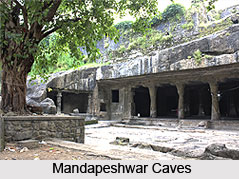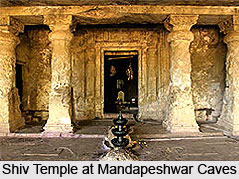 Mandapeshwar Cave is situated in Mount Poinsur, Borivali. Originally they were situated on the banks of the Dahisar River. However the course of the river changed later. Mandapeshwar caves are small. The name of the cave Mandapeshwar means "Mandap Pe Eshwar" which means "Hall of painting of Lord". The ruins of an old Portuguese-built church stand atop the caves. The Immaculate Conception Church is located to its south end. There is an open ground in front of the caves which is used as a playground and parking area by slum dwellers from the slum in front of it.
Mandapeshwar Cave is situated in Mount Poinsur, Borivali. Originally they were situated on the banks of the Dahisar River. However the course of the river changed later. Mandapeshwar caves are small. The name of the cave Mandapeshwar means "Mandap Pe Eshwar" which means "Hall of painting of Lord". The ruins of an old Portuguese-built church stand atop the caves. The Immaculate Conception Church is located to its south end. There is an open ground in front of the caves which is used as a playground and parking area by slum dwellers from the slum in front of it.
It is believed that the caves were built approximately 1500 to 1600 years ago. It was converted to a monastery by the Portuguese. The sculptures of these caves are estimated to have been carved out at the same period. It contained the largest Mandapa and a prominent Garbagriha. These caves have witnessed a series of invasions in the surrounding areas by different rulers.
History of Mandapeshwar Cave
The Mandapeshwar caves perhaps have the most tangled history of all the Mumbai caves. Firstly it was a Hindu temple which was targeted by the Portuguese, who asserted their religious beliefs over it by literally building a monastery and a church dedicated to "Our Lady of Immaculate Conception" on top of the cave temple. Francis Porto founded the monastery and church in 1544.
Later in the 18th century the church was dishonored after the Battle of Bassein in which the Marathas defeated the Portuguese. They uncovered and worshipped the rock-cut sculptures again, but towards the end of the 18th century the British defeated the Marathas and the caves once again functioned as a place of Christian worship. After the end of colonial rule the church fell into disrepair and the caves gradually reverted to the worship of Lord Shiva. The church, including its roof, has been destroyed. Lastly, when the Portuguese came to India, they raised a monastery over the rocks.

Structure of the Mandapeshwar Cave
The cave has a number of steps, which lead up to a rectangular forecourt with four carved pillars, which looks into three chambers. It also has a central unornamented sanctum. The Mandapeshwar caves houses a number of Shiva Lingams. The original Nandi of this shrine was damaged. There are a few relief panels on alcoves. It includes one depicting Shiva as Nataraja and another depicting the marriage of Lord Shiva and Goddess Parvati.
The caves also have sculptures of Nataraja, Sadashiva and a splendid sculpture of Ardhanarishvara. It also has Ganesh, Brahma and Vishnu statues. It depicted the mythical tales of the Hindu gods and goddesses. Mandapeshwar caves have been declared as an archaeological heritage site.
A huge cross can be found at the entrance of the cave. Prayers were held in the past in front of this cross. Behind the ruins of the old chapel is a wall that marks the boundary of the present day church, and one can see the tombstones of the graveyard across the wall
Nearby Places to Visit
Kanheri Caves: These are supposed to be made in the 3rd century BC when Mumbai was a part of Magadha Empire. These too are an explicit example of rock cut architecture.
Jogeshwari Caves: Located in the Eastern Part of Mumbai near the Jogeshwari Railway Station. These rock cut caves are dedicated to the Lord Shiva and are one of the oldest caves of Hindus.
Kolaba Causeway Market: It is one of the main markets for shopping.
The Aquarium: Lying in the heart of the city it has an entire range of fishes of all colors and sizes swimming across.



















